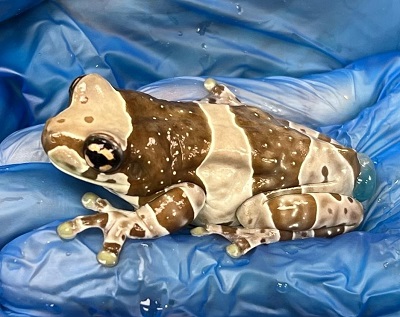
It’s the last day of November and it’s time for our Animal of the Month, the Amazon milk frog, to hop out of the spotlight. We hope you spent some time with us on Twitter @ExoticPetVets as we tweeted about these mighty South American frogs all month long. If you happened to miss any of our tweets, you can find a summary right here for your reference. Did you know?:
- Amazon milk frogs (Trachycephalus resinifictrix) are a large species of frog endemic to the northern part of South America.
- As their name suggests, Amazon milk frogs are found in the Amazon basin, which is the land area drained by the Amazon river and its tributaries. The Amazon rainforest is part of the basin.
- Amazon milk frogs have a large natural range, given that the Amazon basin covers approximately 7,000,000 sq kms (2.7 million sq miles) which represents about 35-40% of the continent.
- In terms of the countries in which they are found, wild Amazon milk frogs are found in parts of Brazil, Suriname, Bolivia, Guyana, French Guiana, Ecuador, Colombia and Peru.
- According to the IUCN Red List, to date there has been only one recorded spotting of Amazon milk frogs in Venezuela. That was in 1988.
- Amazon milk frogs have a very literal name! In addition to being found in the Amazon basin, the milk part of their name refers to the milky substance they secrete when they’re stressed.
- Amazon milk frogs are also commonly known as the mission golden-eyed tree frog because their irises are golden and their pupils are shaped like a black Maltese cross.
- Another common name for the Amazon milk frog is the blue milk frog. They have blue toes and the inside of their mouths is blue.
- In Portuguese, they are known as “sapo canoeiro,” which translates into “boatman frog” – a nod to the sound of their croak, which sounds like oars hitting the side of a canoe.
- In the wild, Amazon milk frogs live in tropical rainforests. They are arboreal, meaning they live in the tree canopy. They rarely, if ever, venture down to the forest floor.
- Compared to South America’s other endemic frogs, Amazon milk frogs are one of the largest species on the continent. Adults grow to lengths between 2.5 – 4 inches (6.3 – 10 cms), with females larger than the males.
- Amazon milk frogs are light grey with a banded pattern of black or brown all over their bodies. This colouration camouflages them effectively in the tree canopy.
- Juvenile Amazon milk frogs have more of a distinct colour contrast in their skin. But as they age the colours fade a bit, muting the dramatic contrast. They also have smooth skin, which develops bumps as they mature.
- Amazon milk frogs are carnivores and will eat spiders, insects, small amphibians and invertebrates – and anything else that they can fit into their mouths.
- Amazon milk frogs are ambush predators, but they don’t catch their prey with lightning-fast tongues like some other frogs do.
- Instead, Amazon milk frogs will grab prey with their mouths and will use their forelimbs to help shove their meal into their mouths.
- Did you know that Amazon milk frogs use their eyeballs to help them eat? While eating, they will depress their eyes into the top of their mouths to help them swallow their meals.
- Fans of the TV show “Seinfeld” know that Festivus is just a month away. And if Amazon milk frogs participated in Festivus, they would win the feats of strength every time.
- Because they are arboreal, Amazon milk frogs have sticky toe pads that are made for climbing and are so strong that they can hold up to 14 times their body weight!
- Amazon milk frogs in the wild mate during the rainy season, which runs from November to May.
- Male Amazon milk frogs will find an area where eggs can be laid, which is typically in a tree cavity filled with water. They will then call out for females to join them in the tree cavity.
- When a female Amazon milk frog shows up, she will lay between 2,000 and 2,500 eggs which the male will cover with sperm. It only takes 24 hours for the eggs to hatch.
- The male will then call for another female to lay eggs next to the original clutch. But he won’t fertilize this second clutch. That’s because these unfertilized eggs will be used as food for the tadpoles.
- The tadpoles will develop into young frogs (froglets) in approximately 3 to 4 weeks and will leave the tree cavity at around this time in their development. Amazon milk frogs become sexually mature at a year of age.
- When they feel stressed or threatened, Amazon milk frogs secrete a milky substance that is poisonous and can make potential predators sick.
- Because of this poisonous substance, Amazon milk frogs don’t have many natural predators.
- While they appear to have a stable population in the wild, Amazon milk frogs face significant threats from human activity that could have a devastating impact on their numbers.
- Amazon milk frogs are under threat of habitat destruction due to deforestation as humans clear trees to make way for agricultural land, housing and other construction projects.
- Like all frogs, Amazon milk frogs have permeable skin so pollution is a big problem for them as pollutants and other toxins can enter their bodies through their skin.
- Amazon milk frogs can live up to 15 years, but it has been reported that they can live even longer in captivity under optimal husbandry conditions.

